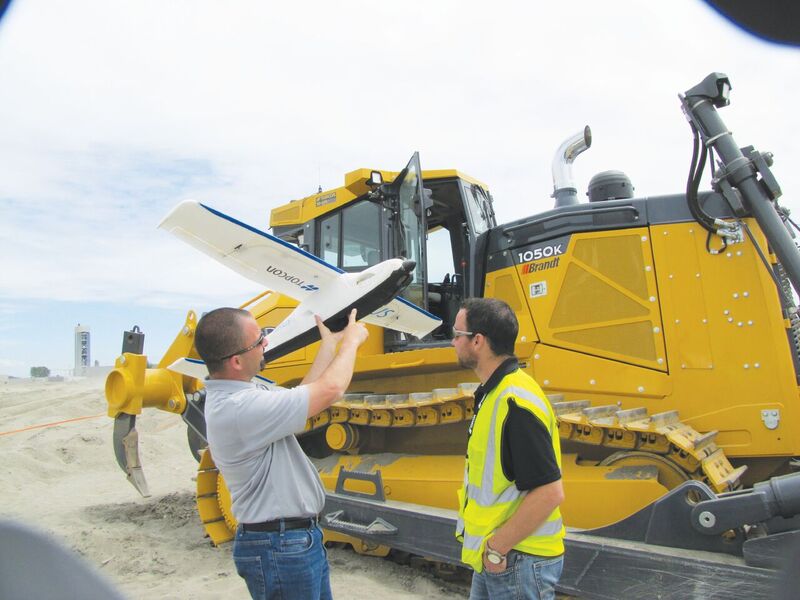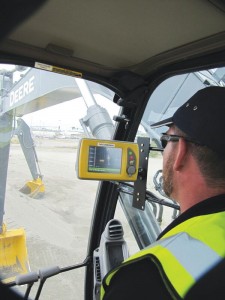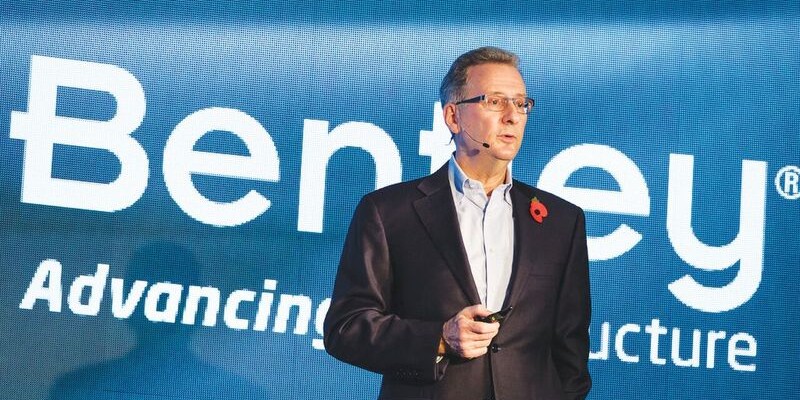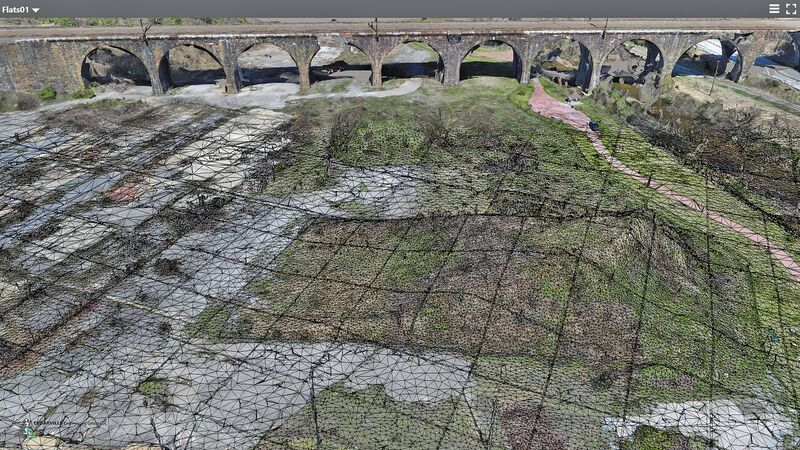To remove workflow barriers among surveying, engineering, and construction, Topcon Positioning and Bentley Systems are teaming up.
Compartmentalization in AEC workflows is a universal curse, with individual segments in design and construction often operating more like discrete enterprises than integral phases. All too often, legacy processes are plagued with a series of fits and starts. Planners do needs analysis, then “throw the files over the wall” to surveying/engineering. Surveyors do pre-design mapping, then “throw the files over the wall” to design. This chain of individual processes continues up through construction, commissioning, and operations.

Header image: Greg Bentley, CEO, Bentley Systems. Above: Ray O’Connor, president and CEO, Topcon Positioning Group, announced the collaboration in “constructioneering” during the keynote address of The Year in Infrastructure 2016 Conference.
In such a scenario, there could be completely different data-management systems and software suites involved in each “compartment.” Data-transfer protocols and formats might vary with each step, and there might be different communications and management structures–surprisingly even within a single design-build firm.
Even though discrete processes can be made to work in linear workflow, implementing real-time management of change orders can become unwieldy.
Great advances have been made in increasing engineering and production efficiencies in each individual discipline: technological wizardry, automation, mass data capture, real-time management, rules-based 3D design, and more. Improvements in each should yield accumulative gains, but why has the construction industry experienced declining or modest productivity? The devil is in the details of getting these individual advances to work together. The good news is that progress is being made.

The collaboration seeks to remove workflow barriers by opening seamless bi-directional cloud access for data 3D models among Topcon’s MAGNET suite and Bentley’s ProjectWise CONNECT and ContextCapture.
Constructioneering
In the keynote address for Bentley Systems The Year in Infrastructure Conference (London, November, 2016), CEO and co-founder Greg Bentley invited Topcon Positioning Group president and CEO Ray O’Connor to jointly announce a collaboration in connecting the two companys’ respective cloud services to enable “constructioneering.”
Before we get to the solution specifics, let’s look at this relatively new term. As could be expected with any new term floated in industry, some people might express a bit of scepticism. “Is this just a buzzword?”
That was our first reaction, but we soon found that a real foundation in proven solutions (Topcon MAGNET Enterprise, Bentley ProjectWise CONNECT, and ContextCapture) is being brought together to remove barriers in traditionally compartmentalized workflows.
Topcon and Bentley have settled on the following definition:
“Constructioneering combines surveying, engineering, and construction workflows to provide new efficiencies in creating affordable, smart, and sustainable infrastructure globally. The concept allows users to start from a reality-captured survey context and leverage and update their digital engineering models throughout the construction process in real time.”
Compared to traditional workflows between design and construction in which data from survey and digital engineering models can be lost and inefficiently recreated, constructioneering provides seamless integration for constructible models that offer real-time updates and data exchange for improved efficiency and cost reduction.
You may have heard the term “constructioneering” in a different context, as a colloquialism from the past. It was used to refer to building something (mostly DIY projects) by “engineering it while you build it” or “field-fitting” the entire structure.
While amusing, the slang version is not completely removed from the more recent, formal use of the term. The present use refers to more closely coordinating surveying and engineering with construction: real-time updates from captured survey data informing rapid engineering decisions to improve the construction process.
Components
“We each use 3D models in surveying and engineering and construction,” Bentley said in his keynote at the UC. р”Why canуt they be the same 3D models? And could we call that constructioneering?”
Bentley announced a new cooperation with Topcon Positioning Group that “has many aspects, including our joint cloud services, with each offering services of the other.” He introduced Topconуs Ray O’Connor by acknowledging Topcon as “a leader in positioning and measurement systems for surveying and construction.”
That such collaborations are happening is logical. In this case, Bentley Systems is a leader in design software for AEC and Topcon in positioning and measurement, so rather than try to “do it all,” these firms are tapping into each other’s strengths.
Topconуs Ray O’Connor then took to the stage. “For the past 25 years, Topcon has been driven by an overriding vision: the automation of construction, the largest manufacturing industry in the world. This vision has been hard to explain and even harder to prove that it can be done.” O’Connor continued by saying that, “‘Constructioneering’ was the perfect word to grab attention and understanding for what we have been working towards for so long.” (See our article, “The Digital Site“)
Topcon’s platform for managing connectivity and data of their measurement instruments, sensors, and control systems is the MAGNET software suite. With versions for mobile field data collection and layout devices, the flow of data and design to and from the office are joined in the cloud, in real-time, for seamless workflows. Beginning with the release of MAGNET 4.0 in June, 2016, Topcon added direct connectivity to Bentley ProjectWise.
ProjectWise is Bentley’s cloud-enabled system for secure design collaboration and engineering document work-sharing. Through this collaboration with Topcon, the path for surveyed data, scanned point clouds, UAS-derived terrain models, and more can be injected into the design environmentяwithout legacy compartmentalization delays.
In 2014, Bentley introduced the CONNECT Edition of its ProjectWise collaborative system, which organizations have been using for nearly 20 years. The CONNECT Edition converges platform technologies to support a hybrid environment across desktop modeling applications, cloud-services, on-premise servers, and mobile apps. The 3D models are then used in the design and project-management processes, without losing any detail (a hazard inherent in legacy methods for “data hand-off”). An example of this critical hand-off of data is the UAV workflow. Images and control points collected through UAV flyovers require specialized data processing in products like ContextCapture.
ContextCapture is Bentley’s 3D modeling software, noteworthy for its scalability from models derived from a few images or point clouds to mass-data-captureяscans and image setsяcomprising entire cities. Images, scans, and surveyed point cloud data from Topconуs line of measurement systems can be combined to produce real-world, full-scale 3D models.
And with this collaboration, new and updated measurement data throughout the construction and as-built phases can be added without many of the legacy roadblocks. This is getting closer to the vision of “continuous representation of reality” that O’Connor has been championing. (You can read more of his thoughts on this subject in our 2016 interview)
O’Connor spoke about this vision in his keynote address. “A business mantra I grew up with, as I am sure many did, is that you can’t manage what you can’t measure. This has special meaning for Topcon as our core business in precision measurement: surveying instruments, GNSS, scanners and drones, machine control. Our business is constantly evolving.”
BIM principles and workflow enhancements have been adopted in all types infrastructure construction and management, including heavy civil.
O’Connor said, “We live in a 3D world but now work in a 4D environment with 5D constraints and 6D requirements. The new mantra is, ‘You can’t manage in real time what you can’t measure in real time.'”

Mass data capture solutions like mobile mapping systems, scanners, and UAS (above); Updated 3D models can then be cloud-transfered to the site for machine control operations (below).
Extended Benefits
Bentley also sees downstream benefits of this type of collaborative effort. In his keynote address at the Year in Infrastructure Conference, Bentley said, “[These are] convergences between what technology makes possible and some new business opportunities in infrastructure engineering, [working] with significant other parts of the infrastructure supply chain.”
He elaborated on how project delivery can move into a full 3D digital model environment throughout the entire design-build-operate chain. This could result in the models becoming, as Bentley says, “the digital DNA of the assets we build operate, and maintain.”
The goals are not new, but the tools and resources are. Ironically, the age of automation, and particularly machine control, has raised the stakes regarding time sensitivity and seamless data management. Just how long can equipment sit idle waiting for updated digital models? The potential savings of 50% predicted decades ago for construction automation may be achievable only if all the digital parts work harmoniously and the data flows smoothly, and only if the advanced tools are adopted a key sticking point.
In the 2009 report, Advancing the Competitiveness and Efficiency of the U.S. Construction Industry from the National Research Council, earlier studies were cited from the 1990s predicting 50% savings through automation across the board, in delivery time, operation, energy, and maintenance costs, less waste and pollution, better durability and flexibility, and lower construction-related work illnesses and injuries.
These are lofty ambitions, but the report also called out one of the biggest obstacles to improving construction efficiency: hesitance to invest in and adopt workflow enhancements. From a 1983 Business Round Table report: “Only if the owners who pay the bills are willing to take the extra pains and pay the often-small costs of more sensitive methods will they reap the benefit of more construction for their dollars.”

are producing data-rich point clouds and images that can be combined to yield full 3D models at any stage of the design/construct work flow, for example in ContextCapture
Good news on this front comes in the form of cross-discipline collaborations like this one between Topcon and Bentley. The costs and adoption times will not be as onerous as they were in the early days of construction automation.
There have been parallel advancements in all segments, like the measurement and automation specialists who are using the Topcon solutions and the design- and data-management specialists using Bentley solutions; no one must make major capital outlays (as these are likely software suites and solutions each segment is already using), nor spend substantial time learning how to use each other’s solutions.
In short, some of the barriers to real-time collaboration between the two worlds have been removed. They represent only the first few steps, but theyуre some pretty big steps all the same.
Affordable, smart, and sustainable infrastructure. Actively connecting the virtual with the real. Creating a truly digital site. These goals are much discussed and touted. Is рconstructioneeringс simply another buzzword, re-branding of existing ideas? We think not. It is probably a good bet that this new term will become a permanent entry in the lexicon for surveying, design, and construction.
These two companies, as their respective visionary CEOs have stated, have provided real-world solutions to break down barriers to increasing efficiency.


